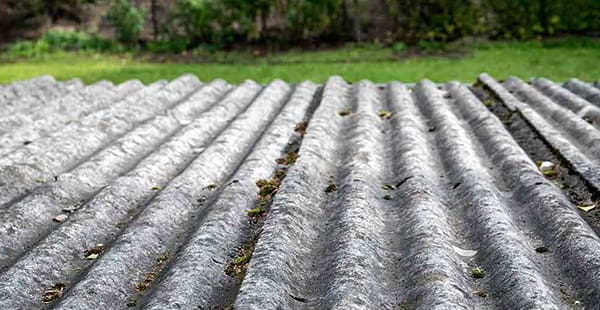Why Was Asbestos Used in Cement Sheets?
For decades, asbestos was added to cement sheets for strength, flexibility and heat resistance. These sheets were easier to handle and more moldable than heavy cement. In the United States, the construction industry commonly used asbestos cement sheets in roofing, siding and other places in the home.
Some of the earliest records of asbestos cement sheets come from Keasbey & Mattison Company. In 1907, it began selling Ambler Asbestos Sheets, which the company made at its factory in Ambler, Pennsylvania.
By the 1950s, other large companies added various corrugated cement sheets and asbestos panel products to their catalogs. For example, National Gypsum added the mineral to its popular Gold Bond brand.
U.S. agencies began to introduce asbestos regulations in the 1970s. By 1985, most U.S. companies had stopped using asbestos in cement sheets.
But asbestos products may still be present in older homes and buildings. As materials age, get replaced or renovated, cement sheets may release airborne asbestos fibers. Inhaling or ingesting these fibers can lead to serious diseases, like mesothelioma cancer.
Asbestos Cement Sheets History at a Glance
- Other Names: AC sheet, asbestos board, asbestos cement board, asbestos cladding, asbestos panel, asbestos roofing, asbestos sheets, fibre cement board, fibrous cement sheet, roof sheets
- Years of Manufacture: Early 1900s – Present
- Military Use: Barracks, buildings, equipment
- Places Used: Commercial and residential construction, oven linings, roofing, siding, tabletops, vault linings
- Asbestos Use Banned: Chrysotile asbestos was banned for new uses in 2024, but some old cement sheets may still contain asbestos
- Noteworthy Brands: GAF Corporation, Johns-Manville, Keasbey & Mattison Company, National Gypsum Company
Dangers of Asbestos in Cement Sheets
As a result of exposure to asbestos sheets, many individuals have developed asbestos-related diseases. These diseases include asbestosis, lung cancer and mesothelioma, among others. Anyone who lives around or works with asbestos sheets is at risk of exposure and developing related illnesses.
In several studies, researchers documented a connection between asbestos cement workers and health risks.
For example, researchers studied 6,931 employees at an asbestos cement plant in New Orleans. The study found long-term exposure was linked to higher rates of lung cancer and mesothelioma among employees at the plant.
Asbestos cement sheets are no longer produced in the United States. However, asbestos is still used in cement sheets in some countries. A 2021 Korean study analyzed the Excess Lifetime Cancer Risk of residents of corrugated asbestos cement roofed houses. The study authors rated the risk of asbestos exposure from living in or demolishing these homes as medium. The authors also highlighted that there is no safe amount of asbestos exposure and that more studies on this exposure were needed.
Cement sheets imported from other countries may still contain asbestos, which continues to put individuals at risk. But new asbestos regulations banning chrysotile asbestos will hopefully end this practice in the near future.
Do I Need to Replace My Asbestos Roof?
If an asbestos roof is damaged, it poses exposure and health risks. In this case, having the roof replaced by professionals might be the best option. If the asbestos roof is in good condition, replacement may not be necessary. An asbestos abatement expert can help you make the safest decision.
List of Asbestos Cement Sheets
A variety of asbestos cement products were used in the construction industry. These products were commonly made by mixing chrysotile asbestos fibers with cement. Workers would then mold the mixture into sheet form.
Asbestos sheets were used in roofs, walls, tabletops and siding. Various types of cement sheets were made with asbestos.
- Asbestos flat sheets were made with cement, asbestos fiber and silica. They were particularly useful because they were water-resistant and could be molded into many shapes using a wet-molding technique. Flat sheets had many applications, including decorative siding, fire-resistant walling, lining for ovens and vaults, laboratory tabletops and roofing. They were used in residential and industrial applications.
- Corrugated asbestos sheets were manufactured with cement and asbestos fibers. These sheets contained anywhere from 15% to 40% asbestos. These asbestos sheets were a durable and affordable alternative to corrugated metal sheets. The asbestos sheets were commonly used as siding and roofing in factories, warehouses and agricultural buildings.
- Asbestos board is a type of asbestos cement flat sheet. Asbestos board was also known as cement wallboard or asbestos millboard. It was commonly used as fireproofing and for barriers around hot equipment, such as boilers and ovens. In cars, it was used in hood liners. In electrical appliances, asbestos board was used to insulate gaskets and washers.
- Asbestos lumber was also manufactured using the flat sheet process. It was marketed as a fire-resistant alternative to actual lumber, though it contained no wood. It was used in similar applications to plywood, such as roofing and flooring underlayment for products like shingles, tile and false brick.
These asbestos sheet roofing, flooring and fireproofing products were once manufactured by several U.S. asbestos companies. As a result of asbestos use, many of these companies now face asbestos lawsuits.
Who Is at Risk of Asbestos Exposure From Cement Sheets?
Carpenters, masons and other individuals who worked with asbestos sheets may have experienced occupational exposure. Individuals who made cement sheets were at a particularly high risk of exposure.
During the manufacturing process, workers often handled raw asbestos. In many cases, employees were not given protective clothing or equipment. This led to high rates of asbestos disease among cement workers and manufacturers.
Homeowners and residents may also risk exposure from asbestos building materials such as cement sheets. If asbestos sheets remain intact, they are not considered dangerous. However, cement products may become dangerous if workers cut into them.
During a renovation, demolition or natural disaster, asbestos sheets may crumble. Airborne asbestos may put nearby residents at risk of developing mesothelioma or another asbestos illness.
Asbestos Lawsuits, Settlements & Other Compensation
Individuals who develop an illness from exposure to asbestos sheets may seek compensation. An asbestos attorney can help individuals determine which legal options they should pursue.
Asbestos victims may seek compensation by filing lawsuits and asbestos claims. As part of bankruptcy proceedings, some companies have also established asbestos trust funds. Companies design these trusts to compensate current and future asbestos victims.
For example, Celotex Corporation and National Gypsum Company once manufactured asbestos sheets. Both companies have established trust funds.
Compensation Following Exposure From Cement Sheets
In 2001, a San Francisco jury awarded a former employee of Johns-Manville and his wife $2.3 million. For 14 years, he worked for the company in various roles. He was later diagnosed with an asbestos-related disease. The jury determined the cause was asbestos used by Johns-Manville. The company added the mineral to many of its products, like cement sheets.
In these cases, a jury award or settlement may help victims and their loved ones cover treatment costs. Financial compensation may also help families pay for travel, end-of-life costs and other expenses.
Safely Removing Asbestos Cement Sheets
The Environmental Protection Agency (EPA) classifies asbestos corrugated sheets as Category II, nonfriable material. This classification means the sheets pose a health threat and must be removed before demolition or renovation work can begin.
Intact asbestos cement sheets are subject to few formal regulations for removal. The EPA recommends removing intact sheets by carefully detaching the materials from their placement and lowering them to the ground before demolishing them.
However, when the sheets are damaged, they are subject to National Emission Standards for Hazardous Air Pollutants (NESHAP) regulations. NESHAP requires at least one representative trained in the regulations to be onsite during removal and demolition. The abatement crew then must follow specific NESHAP regulations, including:
- Wetting the materials to keep the fibers from becoming airborne
- Removing the materials in whole pieces
- Sealing the wet materials in a leak-tight container
- Labeling and disposing the materials at an asbestos-qualified landfill
If asbestos-containing materials are improperly removed, the mineral’s fibers may become airborne. Asbestos in the air creates a health risk to nearby workers and residents. If asbestos fibers are inhaled, they may embed in the linings of the lungs, chest or abdomen. Over time, this may lead to mesothelioma and other illnesses.
To avoid asbestos exposure, untrained workers and residents should not attempt to remove asbestos. People should hire an abatement contractor to remove or encapsulate asbestos sheets. Asbestos abatement professionals are trained to safely remove dangerous materials.






